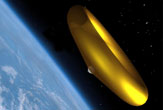Ballutes Studied For Hypersonic Space Vehicles

GlobalAerospace has been given NASA funding to study the use of ballutes in planetaryatmospheric entry and descent, aerodynamic orbital capture, and aerodynamicgravity assist.
Ballutes (from BALLoon plus parachUTE) are basicallylarge, inflatable devices that use atmospheric drag to deceleratespacecraft; they were invented by Goodyear Aerospace in 1958.
The company is developingthe Hypersonic Control Modeling and Simulation Tool (HyperCMST). It will beused to study the problem of controlling the trajectory of different hypersonicspace vehicles as they maneuver close to planets and satellites withsubstantial atmospheres.
HyperCMST will be used todevelop a new type of ballute called a lifting-towed-toroidal-ballute for usein orbit capture or atmosphere entry. Most ballute concepts are used forbraking; drag-only devices that cannot be steered. However, Global Aerospacehopes to manipulate the tether lengths between the spacecraft and the balluteto create aerodynamic lift, making steering possible.
NASA has looked at balluteidea before; most recently, their FlyHigher, Fly Lighter program (2004) aimed to use ballutes to lower the costof putting a satellite into orbit. Taking this approach translates to usingless propellant to slip a satellite into a proper orbit, lower launch costs,and makes more room on spacecraft for sensors and other payload gear.
Sciencefiction fans have already had a great look at the use of ballutes in the1984 movie 2010, a sequel to the earlier ArthurC. Clarke film 2001: A Space Odyssey. Take a look at this dramatic videoclip from 2010 showing the deployment of the ballute on the Russianspacecraft Leonov.
?(This Science Fictionin the News story used with permission of Technovelgy.com)
Breaking space news, the latest updates on rocket launches, skywatching events and more!
- NewVideo - From Science Fiction to Space Fact
- Video? Phoenix Speak?s: A Mars Lander?s Descent
- FlyHigher, Fly Lighter: 'Ballute' Technology Aimed at Moon Missions
Bill Christensen is the founder and editor of Technovelgy, a website dedicated to cataloguing the inventions, technology and ideas of science fiction writers. Bill is a dedicated reader of science fiction with a passion about science and the history of ideas. For 10 years, he worked as writer creating technical documentation for large companies such as Ford, Unisys and Northern Telecom and currently works to found and maintain large websites. You can see Bill's latest project on Twitter.
